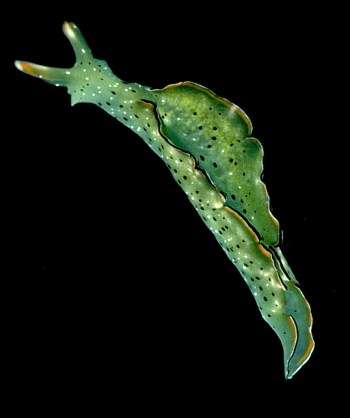
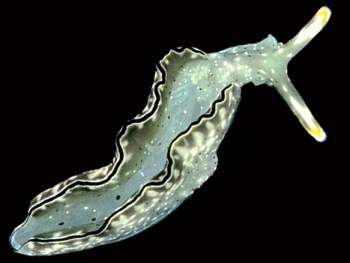
Elysia ornata
(Swainson, 1840)
Order: SACOGLOSSA
Superfamily: ELYSIOIDEA
Family: Elysiidae
DISTRIBUTION
Circum-tropical: Caribbean and Indo-West Pacific.
PHOTO
UPPER: Koumac Beach (=Baie de Ouanap), near Koumac, New Caledonia, mixed soft and hard substrate, grassbeds, algae, October 1993, 37mm long alive.
LOWER: Pointe de Pandop, near Koumac, New Caledonia, intertidal, October 1993, 14mm long.PHOTOS: Bill Rudman.
Elysia ornata was originally described from the Caribbean. Recent anatomical studies suggest that Elysia marginata (Pease, 1871) from the Indo-West Pacific is the same species. The animal is usually a translucent green colour with a black parapodial margin and a submarginal yellow or orange band. Sometimes there is a white line between the orange and yellow bands. The tip of the rhinophores often have the same colour bands. There are also numerous black and white dots all over the body. A very similarly coloured species, from the Indo-West Pacific, Elysia grandifolia, has much larger, very thin parapodia. Jensen (1992) reports that E. ornata feeds on Bryopsis in both the Caribbean and the Indo West Pacific.
See Kathe Jensen's message for a discussion on the taxonomy confusion surrounding this and similarly coloured species.
Reference:
• Jensen, K.R. (1992) Anatomy of some Indo-Pacific Elysiidae (Opisthobranchia: Sacoglossa (=Ascoglossa), with a discussion of the generic division and phylogeny. Journal of Molluscan Studies, 58(3): 257-296.
Rudman, W.B., 1999 (November 4) Elysia ornata (Swainson, 1840). [In] Sea Slug Forum. Australian Museum, Sydney. Available from http://www.seaslugforum.net/find/elysorna
Related messages
Re: Elysia ornata from French Polynesia
January 15, 2009
From: Cynthia D. Trowbridge
Concerning message #3309:
Dear Bill and Daniel,
I just came across this old message and thought I would mention a recent Venus paper about body coloration in this species.
Hirose, M., H. Suzuki, and T. Yamamoto, T. 2003. Body color and growth of Elysia ornata (Opisthobranchia: Sacoglossa). Venus, 62: 55-64.
Cordially,
Cynthia
sacoglossans@ymail.com
C.D. Trowbridge, 2009 (Jan 15) Re: Elysia ornata from French Polynesia. [Message in] Sea Slug Forum. Australian Museum, Sydney. Available from http://www.seaslugforum.net/find/22136Thanks Cynthia,
I must have a look at it
Best wishes,
Bill Rudman
Elysia ornata from Carriacou in the Caribbean
December 11, 2008
From: Brian Mayes
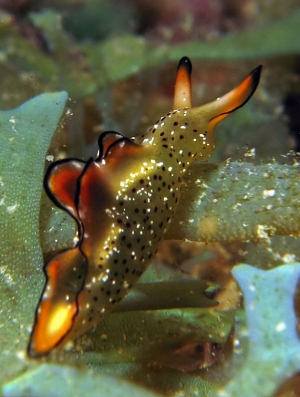
Concerning message #5727:
Dear Bill,
I've just come across Kathe Jensen's message [ #5727] and your appeal for photos of Elysia ornata from the Caribbean. Here are photos of two separate examples but both from the same dive site ("World of Dreams") on the same day.
Locality: Mabouya Island, 10 metres, Carriacou, Grenadines, Caribbean, 15 November 2007, Coral reef with some algae growth on dead/dying coral. Length: 20 mm to 40 mm. Photographer: Brian Mayes.
Kind regards
Brian Mayes
brian.r.mayes@gmail.com
Mayes, B.R., 2008 (Dec 11) Elysia ornata from Carriacou in the Caribbean. [Message in] Sea Slug Forum. Australian Museum, Sydney. Available from http://www.seaslugforum.net/find/22083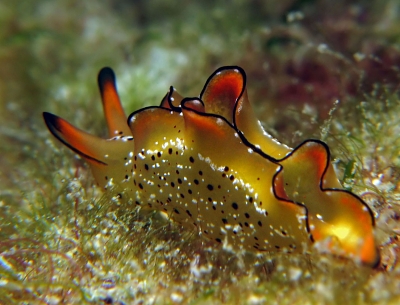
Dear Brian,
I'm afraid I can't report any progress on the E. ornata - E. grandifolia problem discussed in Kathe's message, but accumulating photos such as yours may help us develop an understanding of the colour patterns and body shapes in different geographic areas.
Best wishes,
Bill Rudman
Mating Elysia ornata from Florida
August 8, 2008
From: Linda Ianniello
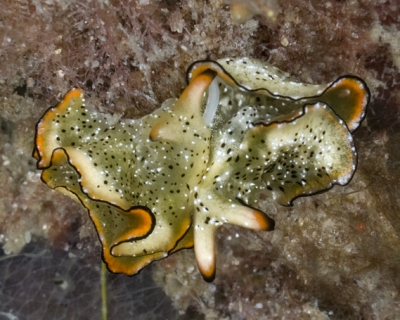
Concerning message #21261:
Dr. Bill
Attached is an image of mating Elysia ornata from the Atlantic. They look just like the Pacific ones, but are "doing something interesting".
Locality: Lake Worth Lagoon, 10 feet, Florida, USA, Atlantic Ocean, 25 July 2008, Intracoastal, tidal. Photographer: Linda Ianniello.
Regards,
Linda I.
lindai1@bellsouth.net
Ianniello, L.M., 2008 (Aug 8) Mating Elysia ornata from Florida. [Message in] Sea Slug Forum. Australian Museum, Sydney. Available from http://www.seaslugforum.net/find/21762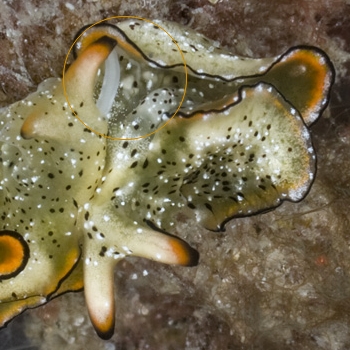
Thanks Linda,
I have a memory of an article discussing mating in E. ornata, but I have drawn a blank with both my memory and my database. Sacoglossans are quite diverse in their mating habits, and while some still make use of genital openings, quite a few have a needle-like tip to their penis and use it to insert the penis - and the sperm - directly through the skin and body wall, into the body cavity of their partner.
Your photo supports my feeling from the earlier message [#21261 ] that in E. ornata mating follows a more normal procedure. The white duct [ringed in photo alongside] is the penis of the animal on the left which is acting as the male. The basal part of the penis is quite thick while the terminal part is very slender. I suspect in this photo the penis is being withdrawn from the female genital opening of its partner. This opening is situated behind the 'neck' on the right of the mid-dorsal pericardial ridge which we can see quite clearly in your photo. In the earlier message both partners seemed to be acting as male and female partners. In your photo it looks like only one was acting as male. I guess it just depends on position.
Best wishes,
Bill Rudman
Mating Elysia ornata from nthn Mariana Islands
February 15, 2008
From: Yuji Fujie
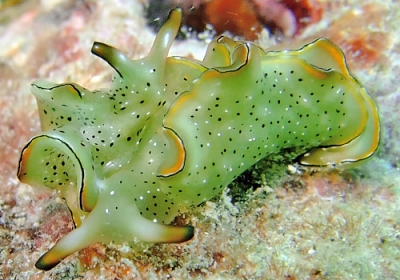
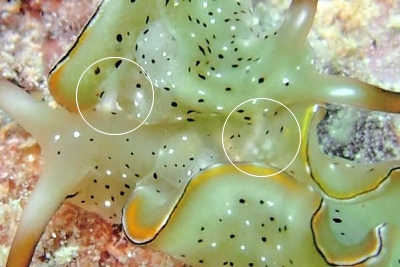
Dear Dr.Bill,
Here are three pictures which we think are ofElysia ornata mating.
They inserted their male reproductive organs into each other for five minutes or more.
Locality: LauLau Beach, 6 m, Saipan, Northern Mariana Islands, Pacific Ocean, 25 October 2007, under the dead coral. Length: 20 mm. Photographer: Yuji Fujie.
Best regards,
Yuji
ds-with@isletwind.com
Yuji Fujie, 2008 (Feb 15) Mating Elysia ornata from nthn Mariana Islands. [Message in] Sea Slug Forum. Australian Museum, Sydney. Available from http://www.seaslugforum.net/find/21261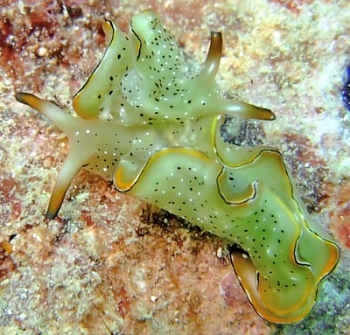
Dear Yuji,
Thanks for these interesting photos. Sacoglossans have some interesting mating behaviours and some have unusual reproductive anatomy, some even lack a vaginal opening for their partner's penis so that sperm can only be exchanged by the parner stabbing a hole through the skin of their partner. I am not sure what happens in Elysia ornata, but from your photos the penis in both animals seems to be inserted on the right side of its partner just near the opening of the right parapodia, which is where the vagina opens, when it is present [see rings]. So it looks like E. ornata has a 'normal' reproductive system with reciprocal mating, both partners acting as male and female simultaneously.
Best wishes,
Bill Rudman
Elysia thompsoni? - Fremantle, Western Australia
June 28, 2007
From: Brent Murdoch
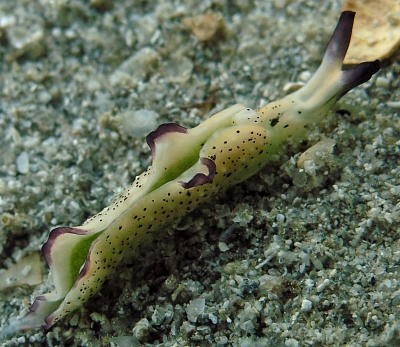
Having a lot of problems with this one!
It does not have the same coloring as Elysia thompsoni but that is closest I can find. As far as I can tell it has not been seen in the Swan River before, which adds to me being sceptical.
Locality: Fremantle, Swan River, 6.5 m, Western Australia, Indian, 02 February 2007, sandy. Length: 55 mm. Photographer: Brent Murdoch.
Thanks in advance
Brent Murdoch
brent@murdoch.id.au
Murdoch, B.D., 2007 (Jun 28) Elysia thompsoni? - Fremantle, Western Australia. [Message in] Sea Slug Forum. Australian Museum, Sydney. Available from http://www.seaslugforum.net/find/19499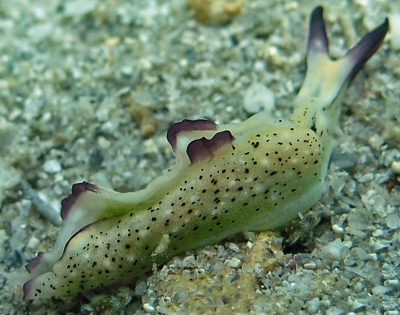
Dear Brent,
I think this is a rather damaged Elysia ornata. Elysia thompsoni is a rather specialised feeder on Acetabularia and I assume it doesn't grow much larger than 10-15 mm. The two purple edged 'lobes' on the parapodia of your animal seem to me to be all that is left of the 'full' parapodia and the area in between has been bitten out. Also the head tentacles are mishapen and partially fused and the head is very strange. I suspect it has been partially bitten off and regrown as well.
Best wishes,
Bill Rudman
Elysia ornata? from Lembeh Strait
May 31, 2007
From: Mike Krampf
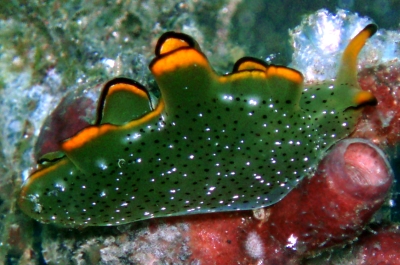
Dear Bill
Is this a colour variation of an Elysia ornata?
Locality: Lembeh Strait, 30 ft, Indonesia, Celebes Sea, 27 October 2006, Sandy bottom. Length: 2 cm. Photographer: Mike Krampf.
Thanks,
Mike
mtkrampf@yahoo.com
Krampf, Mike, 2007 (May 31) Elysia ornata? from Lembeh Strait. [Message in] Sea Slug Forum. Australian Museum, Sydney. Available from http://www.seaslugforum.net/find/18776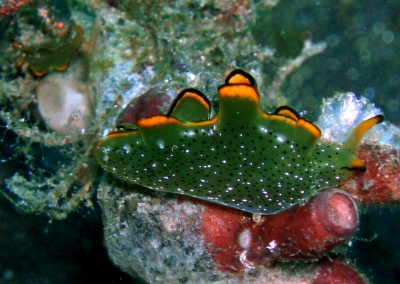
Dear Mike,
I am calling this Elysia ornata but there seems to be a little sorting out which still needs to be done. As I say elsewhere, there may be at least a second species E. grandifolia. I can see a second animal in the background of the uncropped photo alongside.
Best wishes,
Bill Rudman
Elysia ornata? from Bali
July 13, 2006
From: Kevin Lee
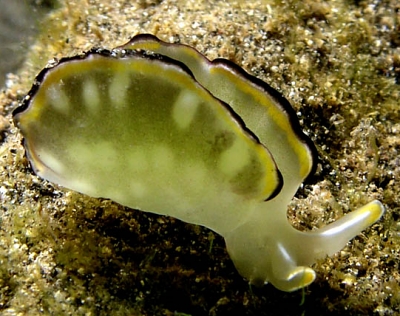
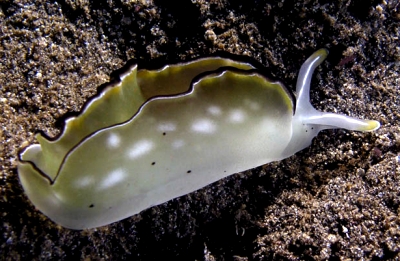
Hi Doc,
Just parachuted back home (California) after doing some dives in Bali and Lombok, Indonesia. Didn't see as many sea slugs as hoped, but would appreciate ID assistance for the ones I did.
The following 3 fotos are separate slugs, but am assuming the same species. It was the only slug, and plentiful, I saw during 2 dives, at Secret Bay, Bali, Indonesia. The largest slug, seemed to have only "nubs" for rhinophores; perhaps they were nibbled away by predators or...?
Locality: Secret Bay, Gilimanuk Town, Between 7 and 15 feet, Bali, Indoneisa, Java Sea, 12 June 2006, Muck dive, mostly muddy sand. Length: approx. 1 inch; 1.5 inches; 2 inches [upper to lower photos]. Photographer: Kevin Lee.
Best regards,
K:-)
diverkevin@gmail.com
Lee, K., 2006 (Jul 13) Elysia ornata? from Bali. [Message in] Sea Slug Forum. Australian Museum, Sydney. Available from http://www.seaslugforum.net/find/16928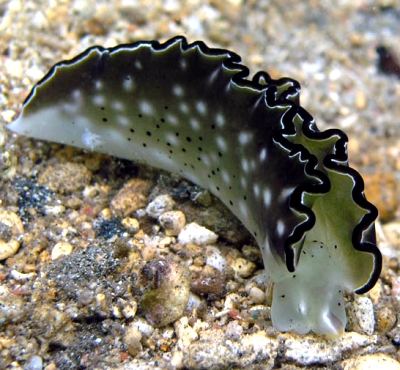
Dear Kevin,
This is a good example of why there seems no easy soluttion to whether Elysia ornata and E. grandifolia are one or two or perhaps even more species. You'll notice that both the upper animals have a distinctive yellow submarginal border on the parapodia but it is absent in the larger lower animal. But in that animal the black spots are more numerous. The intensity of the green colour is unimportant because it reflects the amount of green algal material in the digestive system rather than genetic differences.
At present I am putting most of the elysiids with this colour pattern under E. ornata, but I suspect there will have to be some splitting when this group is studied in detail. I agree that the shortness of the rhinophores in the lower animal is most probably the result of interaction with a predator.
Best wishes,
Bill Rudman
Elysia ornata from Reunion island
June 22, 2006
From: Philibert Bidgrain
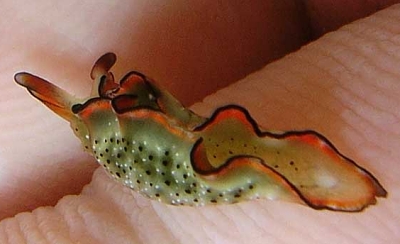
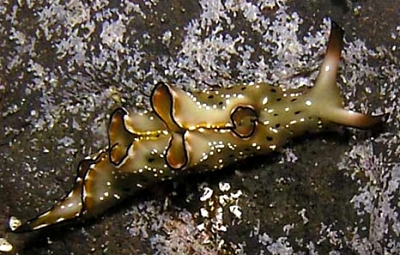
Dear Bill,
Reunion Island sea slugs.
I think that these two are Elysia ornata. They have the black parapodial margin and a submarginal yellow or orange band {interrupted in lower animal).
Reunion island, Indian ocean. Photographer: Hugues Flodrops and Philibert Bidgrain.
What's your opinion about this?
Best Regards
Philibert Bidgrain
http://vieoceane.free.fr/runseaslug/indexslug.htm
pbidgrain@yahoo.fr
Bidgrain, P., 2006 (Jun 22) Elysia ornata from Reunion island. [Message in] Sea Slug Forum. Australian Museum, Sydney. Available from http://www.seaslugforum.net/find/16550Dear Philibert,
Yes these are what I am calling Elysia ornata, but as I discuss in some earlier messages we still need to sort out whether all the animals we present lump together as one species are really one species. Perhaps there are a few species, all with a similar colour pattern?
Best wishes,
Bill Rudman
Elysia from Dubai
March 31, 2006
From: Mike Arora
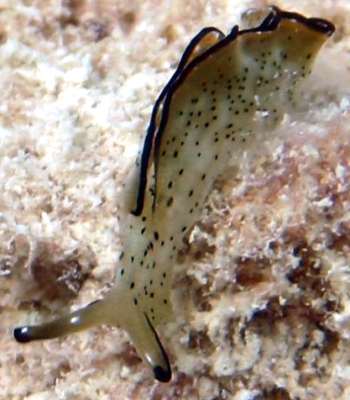
Hi
Really appreciate your website and the great information it holds. I found this creature whilst on a diving trip to Dubai. I'm sure its a common species?? but would appreciate it if you would kindly id it for me.
Locality: Dubai, 3m, UAE, Persian Gulf, 16 February 2006, rocky breakwater. Length: 3.5cm. Photographer: Mike Arora.
Thanks and regards
Mike
michael@phegulf.com.bh
Arora, M.K, 2006 (Mar 31) Elysia from Dubai. [Message in] Sea Slug Forum. Australian Museum, Sydney. Available from http://www.seaslugforum.net/find/16183Dear Mike,
This is a species of Elysia, and is part of a puzzle we could call the Elysia ornata - E. grandifolia complex because we still have to work out how many species there are. If you are interested in following the discussion have a look at earlier messages about both those species.
Best wishes,
Bill Rudman
Re: Elysia ornata from St. Vincent
October 25, 2005
From: Roberto Sozzani
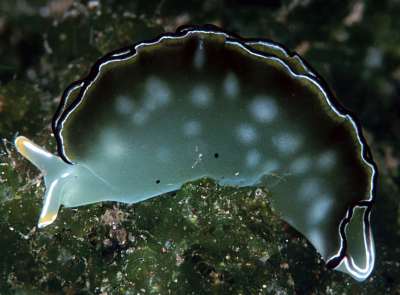
Dear Bill,
Concerning your comments in message #15076: About the color of spots on parapodia of Indo-Pacific species, I've these photos in which we can see also orange spots. Both photos are taken in Nusantara Dua (Secret Bay), in the North-West tip of Bali: the first one on March, when the sandy-muddy bottom is almost clean. The second one in June, when the bottom is completely covered by a green algae, with large and thin leaves, very similar to a plastic film. As you can see, this algae has many orange spots too [see inset in middle right photo ]. Is it possible that this species has developed orange spots for a better mimetism?
Locality: Nusantara II - Bali, Indonesia. Depth: 5 meters. Length: 10 cm. March - June 2003. muddy. Photographer: Roberto Sozzani
Best wishes
Roberto Sozzani
www.robertosozzani.it
roberto.sozzani@fastwebnet.it
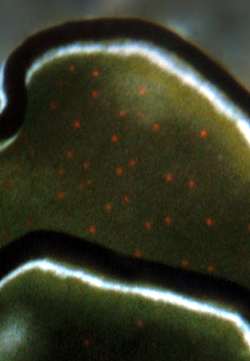
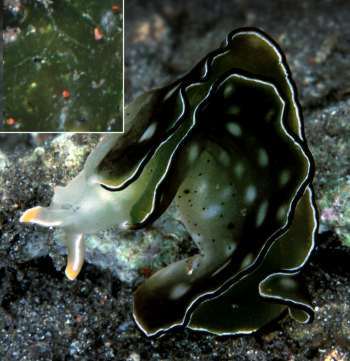
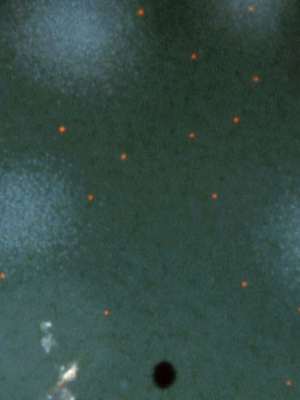
Dear Roberto,
I should have learnt by now not to make definitive statements. You are of course right - although I said Indo-West Pacific animals only have black and white spots, they can, as you illustrate, have orange spots, both on the inside [middle left photo] and outside [lower right photo] of the parapodia. They can also lack the submarginal orange band, or series of markings, at the parapodial edge. I thought at one stage that Caribbean animals were distinguished by having black-tipped rhinophores, but there are a numnber of examples on the Forum of Indo-West Pacific animals with black-tipped rhinophores.
Concerning the possibility that the orange spots mimic the orange specks on the algae. Anything's possible I suppose, but the orange spots on the algae look like like sandgrains. If so, the mimicry would only in places with a similar geology. I guess we would have to survey they species over a large geographic area and see if there is any correlation between orange spots on the animal and orange specks on the algae.
Best wishes,
Bill Rudman
Elysia ornata from St. Vincent
October 21, 2005
From: Les Wilk
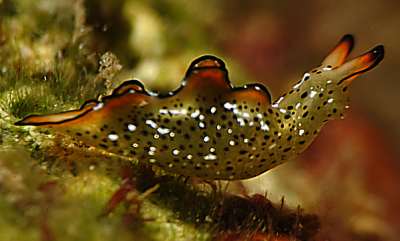
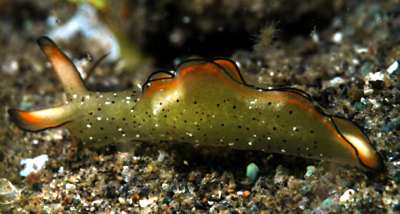
Hi Bill;
You don't seem to have many examples of Elysia ornata from the Caribbean, so here's one from St. Vincent.
Locality: west side of St. Vincent Is., Caribbean Sea. Depth: 30 feet. Length: 1.5 inch. July 2005. grassy bottom. Photographer: Keri Wilk & Les Wilk
Les Wilk
wilk@reefnet.ca
Wilk, L., 2005 (Oct 21) Elysia ornata from St. Vincent. [Message in] Sea Slug Forum. Australian Museum, Sydney. Available from http://www.seaslugforum.net/find/15076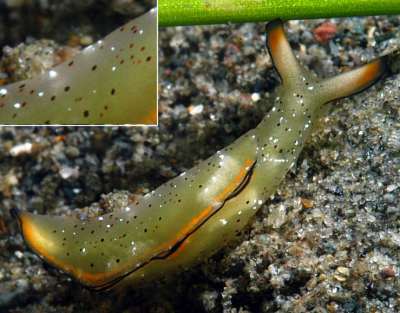
Dear Les,
Thanks for these photos. If you have read some of the earlier messages concerning this species you will have seen that there is some doubt about whether the Caribbean and Indo-West Pacific populations are the same species. There is also some doubt whether all the things we call E. ornata in the Indo-West Pacific are one species. So your photos are very welcome as they at least give us some external features too look at. One apparent difference is that in Caribbean animals there is a distinct gap between the black line at the edge of the parapodia, and the orange inner band. Also there appear to be black, brown and white spots on the parapodia while Indo-West Pacific animals have black and white spots or patches only.
Best wishes,
Bill Rudman
Elysia ornata from South China Sea
May 9, 2005
From: Jimmy Goh
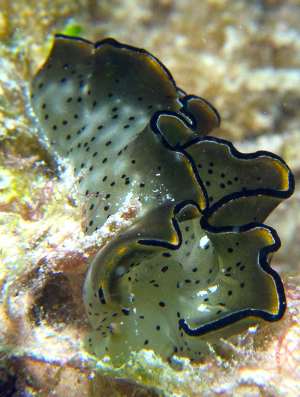
Hi,
I am looking for the exact name for this species. The closest photograph matches is Elysia ornata
1st image is taken at Pulau hantu,
2nd Image is taken at Upper image: Pulau Hantu, Singapore, South China Sea. Depth: 8 m. Length: 70 mm. 21 Jan 2005. On top of some sea grass Photographer: Jim Goh.
Lower image: Layang Layang, Sabah, East Malaysia, South China Sea, depth 4m.
Jimmy Goh
jimz19@singnet.com.sg
Goh, J., 2005 (May 9) Elysia ornata from South China Sea. [Message in] Sea Slug Forum. Australian Museum, Sydney. Available from http://www.seaslugforum.net/find/13734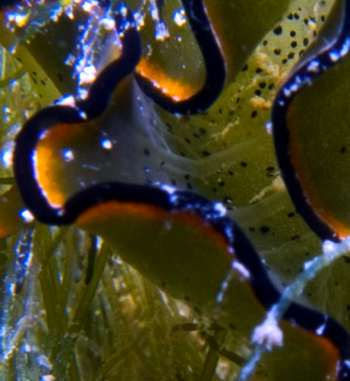
Dear Jim,
This is Elysia ornata. I have used a close-up of your second image as it shows some of the blood-filled tubes which form a vein-like pattern on the inside of the parapodia.
Best wishes,
Bill Rudman
Elysia ornata or E. grandifolia ?
February 23, 2005
From: Marli Wakeling
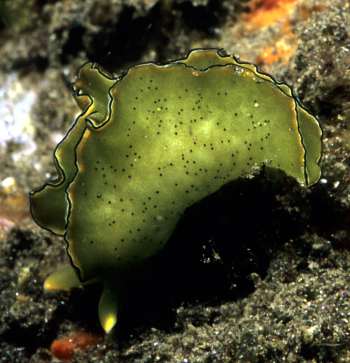
Hi Bill,
I found two Elysia sp. on the same dive, which differ a little in appearance. Are they both Elysia ornata?
Locality: Tulamben, Bali, Indonesia. Depth: 20 feet. Length: 30 mm. 23 July 2005. Sand and silt slope. Photographer: Marli Wakeling
Cheers,
Marli
scubamarli@gmail.com
Wakeling, M., 2005 (Feb 23) Elysia ornata or E. grandifolia ?. [Message in] Sea Slug Forum. Australian Museum, Sydney. Available from http://www.seaslugforum.net/find/15189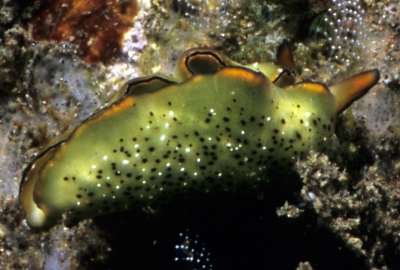
Dear Marli,
I think you are right to be unsure. They illustrate the two 'forms' I have discussed before - the lower one fitting E. ornata with relatively Elysia-like parapodia, while the upper one seems to have large, very thin parapodia - a form I think fits Elysia grandifolia. I think quite a bit more work is required before we will know if there are two or more species.
Best wishes,
Bill Rudman
First record of Elysia ornata from Eilat, Red Sea
January 28, 2005
From: Jacob Dafni
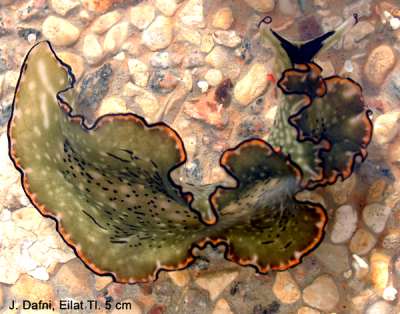
In the Coral World Park aquauria at Eilat very often nudibrach larvae enter with the sea water influx. I found two specimens of Elysia ornata one at the size of 5 cm and another much smaller, ca. 2 cm crawling on the aquarium walls. The northenmost record of this species in the Red Sea was from Arabia, by J. Chuk (in this Forum).
Locality: Eilat, Gulf of Aqaba, Israel, Red Sea
Length: ca. 5 cm. 14 January 2005.
Photographer: Dr. Jacob Dafni
Jacob Dafni
jdafni@netvision.net.il
Dafni, J., 2005 (Jan 28) First record of Elysia ornata from Eilat, Red Sea. [Message in] Sea Slug Forum. Australian Museum, Sydney. Available from http://www.seaslugforum.net/find/12946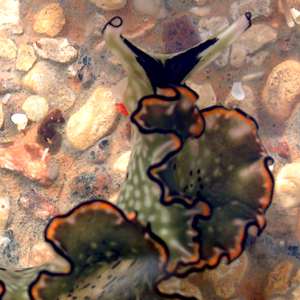
Dear Jacob,
Thanks for this photo. I am not sure if the black patch on the head is significant. It's a bit difficult to be sure whether this is the first record of the species from Eilat as we are still rting to determine just how many species there are. It is part of a complex of species or colour forms variously called E. grandifolia, E. ornata, and E. marginata. I am not sure what the story is but photos of new colour varaints are always welcome
Best wishes,
Bill Rudman
Elysia ornata from Bahamas
March 4, 2004
From: Marina Poddubetskaia
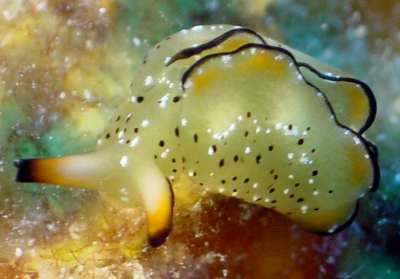
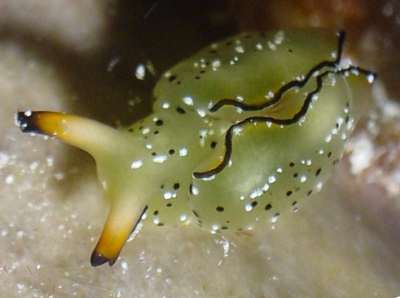
Dear Bill,
I know you have a lot of Elysia ornata photos on the Forum. But I'd like to add this record from the Northern Bahamas. This animal is very similar to the one you have from Florida.
I noted on the Forum that some animals have black tips to the rhinophores and others have yellowish white ones. It's a strange variability...
Date: February 10, 2004
Location: Bimini Islands, Bahamas, Western Atlantic
Site: Riding Rock Reef (night dive)
Depth: 11m
Size: 18mm
Photos: Marina Poddubetskaia - Nembro website
Best wishes,
Marina.
nembro@nembro.info
Poddubetskaia, M., 2004 (Mar 4) Elysia ornata from Bahamas. [Message in] Sea Slug Forum. Australian Museum, Sydney. Available from http://www.seaslugforum.net/find/12356Thanks Marina,
This 'species' may turn out to be more than one, but we need some hard evidence. Unfortunately colour differences don't seem to be consistent, with black-tipped animals occurring in both the Caribbean and the Pacific.
Best wishes
Bill Rudman
Elysia ornata from Malaysia (Mabul)
July 12, 2003
From: Harro Quitzau
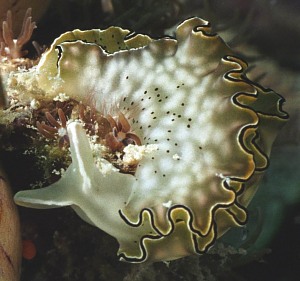
Hello,
I found this one in Mabul (Crocodile Avenue} Malaysia, 9m at March, 9 2003.
I think it's Elysia ornata.
Best regards,
Harro
Harro@Quitzau.info
Quitzau, H., 2003 (Jul 12) Elysia ornata from Malaysia (Mabul). [Message in] Sea Slug Forum. Australian Museum, Sydney. Available from http://www.seaslugforum.net/find/9669Dear Harro,
Yes this is Elysia ornata.
Best wishes,
Bill Rudman
Elysia ornata from Batam, Indonesia
June 23, 2003
From: Alice Lee
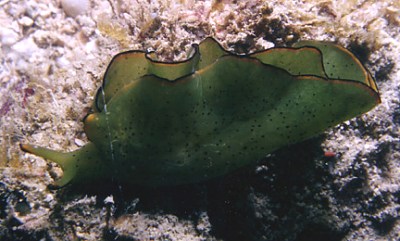
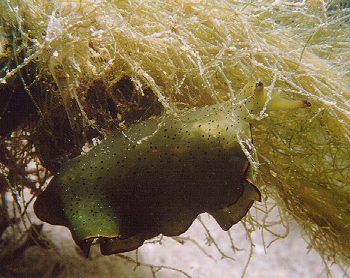
Hi,Bill,
Here are 2 photos of Elysia ornata.
Location: Batam, Indonesia
Depth: 12m
Size: 5cm
I realised that they like to stay in the green sea grass environment. I have seen them around the same area for a month but now they are nowhere to be found. Can you explain what happen?
Thanks.
Alice Lee
alee@dlink.com.sg
Lee, A., 2003 (Jun 23) Elysia ornata from Batam, Indonesia. [Message in] Sea Slug Forum. Australian Museum, Sydney. Available from http://www.seaslugforum.net/find/10225Dear Alice,
The most likely reason for their disapperance is that they have died. If they were 5cm long it suggests they were adult sized. We don't know how long most opisthobranchs live, but from those we do I think we can make an educated guess that Elysia ornata will live for less than a year.
Best wishes
Bill Rudman
Re: Elysia ornata from Indonesia
May 21, 2003
From: Kathe R. Jensen
Dear Danny & Bill,
Elysia ornata eats Bryopsis, a green, feathery, soft filamentous alga. It is difficult for me to see the colour of the filaments in Danny's pictures because of the pink/red background. It appears that the filaments above and behind the slug are "empty" - and thus transparent, whereas those immidiately below the animal (lower right side of picture) have a green tinge. So I guess they could be Bryopsis.
Greetings,
Kathe
krjensen@zmuc.ku.dk
Thanks Kathe,
Bill Rudman
Elysia ornata from Indonesia
May 17, 2003
From: Danny Van Belle
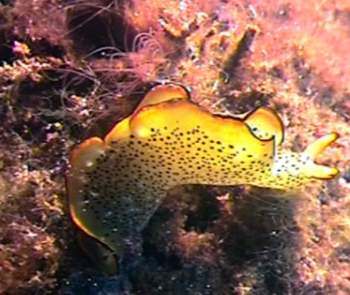
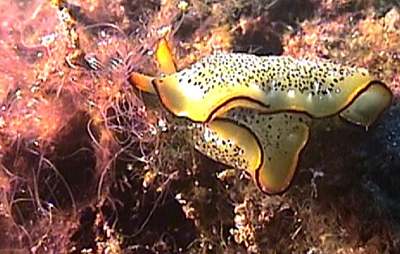
Hi Bill,
Here some nice pictures of Elysia ornata.
I think its feeding on the purplish thread algae - Am I right !
Depth around 5m at Lembeh Strait, Sulawesi, Indonesia.
Danny Van Belle
dannyvb@hotmail.com
Van Belle, D., 2003 (May 17) Elysia ornata from Indonesia. [Message in] Sea Slug Forum. Australian Museum, Sydney. Available from http://www.seaslugforum.net/find/9916Dear Danny,
If we're lucky Kathe Jensen will be able to tell us what this species eats. It certainly seems to be interested in the filamentous algae.
Best wishes,
Bill Rudman
Elysia ornata from Myanmar
April 1, 2003
From: Mary Jane Adams
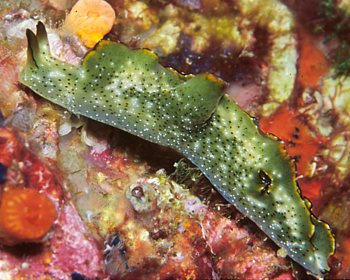
Hi Bill,
I found two species of Elysia crawling on a vertical wall of Black Rock, Mergui Archipelago, Andaman Sea, Myanmar, Feb. 15, 2003. This looks like a typical Elysia ornata. The other one, which was about 20cm away, is more problematical. Both were about 4 to 5cm long. Depth: 4 meters.
Best regards,
Mary Jane
divepng@yahoo.com
Adams, M.J., 2003 (Apr 1) Elysia ornata from Myanmar. [Message in] Sea Slug Forum. Australian Museum, Sydney. Available from http://www.seaslugforum.net/find/9465Thanks Mary Jane,
Yes this is Elysia ornata. I have identified the other one separately.
Best wishes,
Bill Rudman
Elysia ornata from Tufi, Papua New Guinea
March 12, 2003
From: Dave Harasti
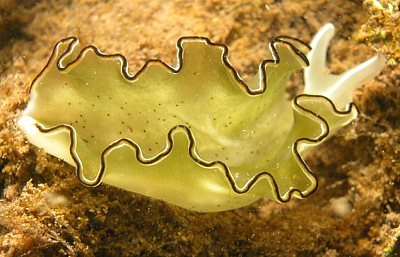
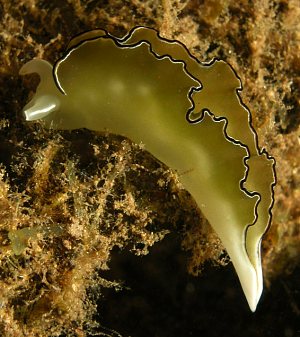
Hi Bill,
I have attached two images of a species that I am unable to identify. The animal was found under Tufi Wharf in Papua New Guinea in January 2003 in about 4 metres of water. Water temp was 30 degrees. Could you please possibly help with its ID?
Regards,
Dave Harasti
diving@webone.com.au
Harasti, D., 2003 (Mar 12) Elysia ornata from Tufi, Papua New Guinea. [Message in] Sea Slug Forum. Australian Museum, Sydney. Available from http://www.seaslugforum.net/find/9251Dear Dave,
This is almost certainly Elysia ornata. There are faint traces of the yellow-orange submarginal line around the edge of the parapodia and the distinctive white line on the rhinophores in your animal are probably the same as the elongate white mark usually present on the rhinophores. The parapodia in this species usually has small black specks and larger white spots. It is interesting that this animal seems to lack the white spots, while the animal in your other message, also from Tufi Wharf, lacks the black specks.
Best wishes,
Bill Rudman
Elysia ornata from Tufi wharf , PNG (2)
March 12, 2003
From: Dave Harasti
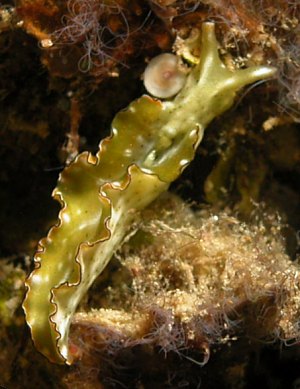
Hi Bill,
Here is another animal that I'm finding difficult to get a correct ID for. Species was found under Tufi Wharf - Papua New Guinea in 10 metres of water. The animal was about 3cm long.
Cheers,
Dave Harasti
diving@webone.com.au
Harasti, D., 2003 (Mar 12) Elysia ornata from Tufi wharf , PNG (2). [Message in] Sea Slug Forum. Australian Museum, Sydney. Available from http://www.seaslugforum.net/find/9253Dear Dave,
This is also Elysia ornata. See my comments on your other message.
Best wishes,
Bill Rudman
Elysia ornata from Chek Jawa, Singapore
February 4, 2003
From: Ria Tan
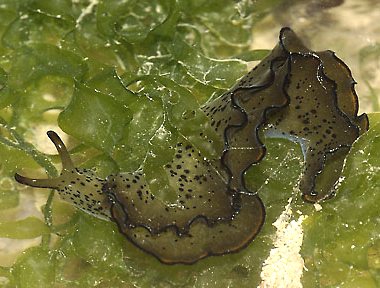
Dear Bill,
Here ia another animal from the intertidal flat at Chek Jawa, Singapore. I think its a Sea Hare. Photo: Alan Yeo
Best wishes,
Ria Tan
tanria@singnet.com.sg
Tan, R., 2003 (Feb 4) Elysia ornata from Chek Jawa, Singapore. [Message in] Sea Slug Forum. Australian Museum, Sydney. Available from http://www.seaslugforum.net/find/9051Dear Ria,
This is a sacoglossan sea slug rather than a Sea Hare. Both groups are herbivores, but the sacoglossans are unique in their very specialised feeding mechanism. Instead of biting or breaking off bits of sea weed and eating them they pierce a hole in the algae and suck out the cell contents. This species is Elysia ornata.
Best wishes,
Bill Rudman
Elysia ornata from South Korea
November 30, 2002
From: Dong Bum, Koh
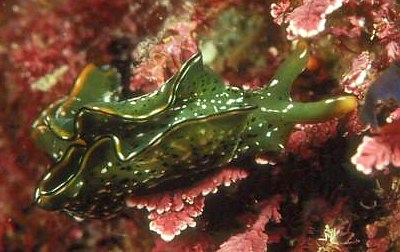
Dear Bill,
Here is a photo of Elysia ornata from Moon islet, Che Ju island, South Korea.
Photo: Dong Bum, Koh
May 2001, 10m depth.
Best regards,
Dong Bum, Koh
drkoh@seasee.co.kr
Koh, D.B., 2002 (Nov 30) Elysia ornata from South Korea. [Message in] Sea Slug Forum. Australian Museum, Sydney. Available from http://www.seaslugforum.net/find/8256Thanks Dong Bum,
This is certainly what I would call a typical specimen of E. ornata
Best wishes,
Bill Rudman
Elysia ornata from nthn New South Wales
August 16, 2002
From: John Pogonoski
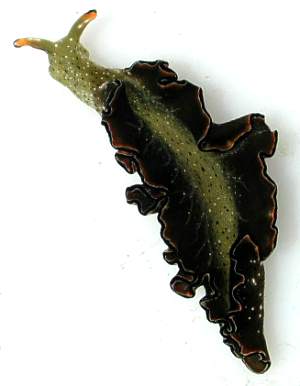
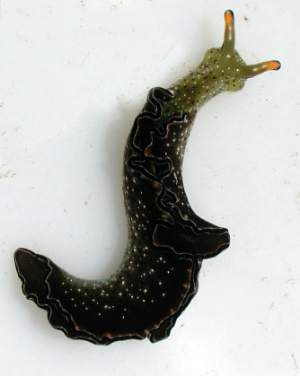
Hi Bill,
Here is an elysiid I collected at
Angourie Pool on our recent trip to northern New South Wales, Australia [March 2002].
John
johnpog@austmus.gov.au
Pogonoski , J., 2002 (Aug 16) Elysia ornata from nthn New South Wales. [Message in] Sea Slug Forum. Australian Museum, Sydney. Available from http://www.seaslugforum.net/find/7771Thanks John,
This is Elysia ornata. The large, very thin parapodia are packed full of green chloroplasts that it gets from the alga it is feeding on. See the pages on Solar Powered sea slugs.
Cheers,
Bill Rudman
Deformed Elysia ornata from Japan
July 9, 2002
From: Jun Imamoto
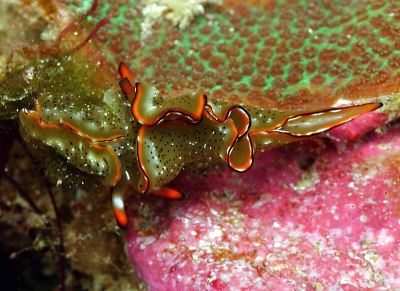
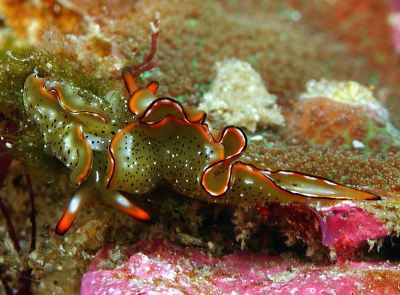
Dear Bill.
I recently saw as shocking a sea slug as the Chromodoris orientalis in Mr. Tomohiko Kurihara's recent message. At first, I thought that it was a pair copulating, but on checking it was a single deformed Elysia ornata. Because the sea was rough, I couldn't do a detailed observation.
Date: 22 June 2002
Location: Futou, Suruga bay, Japan
Size about: 35mm
Depth: 3m
Temperature: 20 C
Best Regards,
Jun Imamoto
imamoto@wips.co.jp
Imamoto, J., 2002 (Jul 9) Deformed Elysia ornata from Japan. [Message in] Sea Slug Forum. Australian Museum, Sydney. Available from http://www.seaslugforum.net/find/7435Dear Jun,
Another interesting find for the Abnormalities Page. It seems to be an example of what we would call 'Siamese' or 'conjoined twins'. In the very early stages of development the egg did not completely divide into two, and each partially separate cell continued to develop as though it was a single individual. I find it hard to imagine how it survived as a planktonic veliger larvae and metamorphosed into its slug form, but clearly it has. An interesting, if somewhat bizarre, find.
Best wishes,
Bill Rudman
Elysia ornata from Taiwan
July 4, 2002
From: Todd Garthwaite
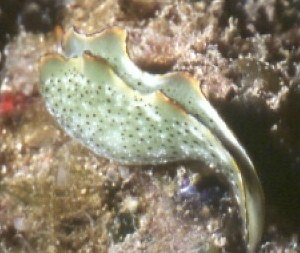
Hi Bill,
Here ia another 'first-time-find' from Dragon Cave Bay, here in Taipei. Here are a few shots of different specimens of, (what I think are), Elysia ornata, which I came across in an area strewn with rocks, rubble, silt, sand, sponges, and very small patches of soft and hard coral. These different specimens were all within close proximity to each other (an area approx. 8 - 9 sq. meters in size).
Site: Nudibranch Alley, (Dragon Cave Bay, N.E. Coast, Taipei, Taiwan)
Date: 27 April 2002
Time: 10:53am
Depth: 10.6 meters
Temp: 21 degrees C.
Size: approximately 19mm
Bill, it's always exciting to come across something new and exotic somewhere you've gone diving hundreds of times before. So far this year has been a good year for 'branching,' here in Taipei County.
Stay golden.
Peace, love, & nudis
Todd Garthwaite
typhoontoddy@yahoo.com
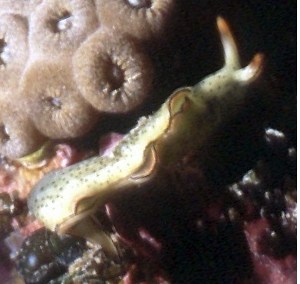
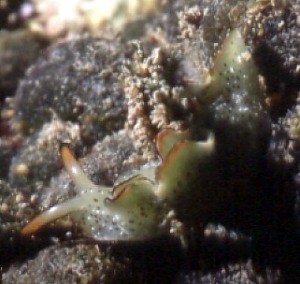
Thanks Todd,
Bill Rudman
Elysia ornata from Florida
March 14, 2002
From: Linda Ianniello
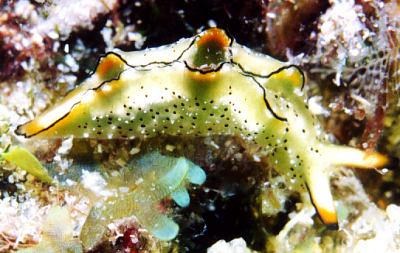
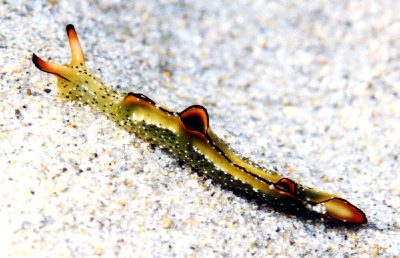
Hi Bill,
Here are two shots of the Caribbean version of Elysia ornata for your collection. Both were found off Delray Beach, Florida, in about 25 feet, one last summer and one this February [2002].
As usual, thanks very much for your help and I really enjoy the Forum.
Regards,
Linda Ianniello
lindai@us.ibm.com
Ianniello, L., 2002 (Mar 14) Elysia ornata from Florida. [Message in] Sea Slug Forum. Australian Museum, Sydney. Available from http://www.seaslugforum.net/find/6425Thanks Linda,
It's nice to be able to compare photos of the Caribbean animal with Indo-West Pacific animals. As well as working out whether the Caribbean species is the same as something in the Indo-West Pacific, is working out whether all the Indo-West Pacific animals with this colour pattern are one species?
Best wishes,
Bill Rudman
Elysia ornata? from Queensland
December 3, 2001
From: Jo Endersbee
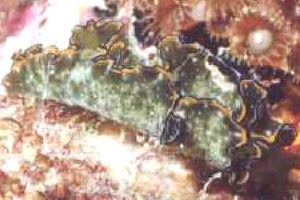
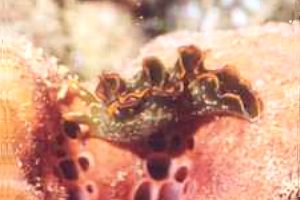
Here are two photographs, probably of Elysia ornata. They were taken on the Yongala wreck, off Townsville, Queensland [Australia]. The larger one was approx. 40mm, the other approx 20mm. They were found actually on the wreck (the only ones I ever saw on the wreck itself, mostly they are found in the rubble on the sandy bottom) at 20-22m depth. They were about 50m away from each other, and this was the first and only time I ever saw this species at the site, after diving it weekly for 6 months.
Jo Endersbee
jo.endersbee@normandy.com.au
Endersbee, J., 2001 (Dec 3) Elysia ornata? from Queensland. [Message in] Sea Slug Forum. Australian Museum, Sydney. Available from http://www.seaslugforum.net/find/5735Thanks Jo,
I think one of the common themes through the Forum is just how unpredictable many opisthobranchs are. However, when you think that those with free-swimming planktonic larvae, drift around for days, sometimes weeks, at the mercy of currents, tidal flows etc, it is a wonder that you find even two together, or near each other.
Best wishes
Bill Rudman
Elysia ornata and an octopus
November 13, 2001
From: Bruce Potter
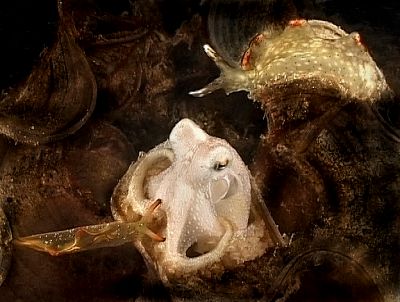
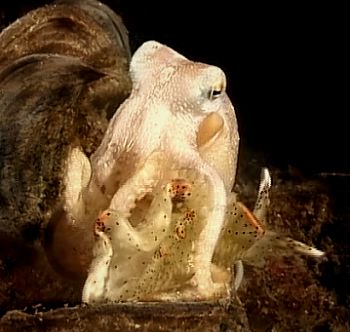
Bill,
I found this very interesting little tableau last night [5 November, 2001]. Two Elysia ornata were trying to make contact, but this tiny octopus was getting in the way. I thought I had found an example of octopus predation when it climbed all over the larger of the two Elysia, but it just continued on its way without apparently doing any damage to the slug.
I watched them for about 10 minutes before the octopus went on its way and left the two Elysia to get together.
Regards
Bruce Potter.
bruce.potter@adventist.org.sb
Potter, B., 2001 (Nov 13) Elysia ornata and an octopus. [Message in] Sea Slug Forum. Australian Museum, Sydney. Available from http://www.seaslugforum.net/find/5648Dear Bruce,
I am surprised the octopus didn't eat the Elysia - they certainly make short work of most molluscs. Perhaps the octopus found the skin secretions of Elysia too distasteful. Thanks for sharing these wonderful photos.
Bill Rudman
Elysia ornata from the Line Islands
October 26, 2001
From: Cory Pittman
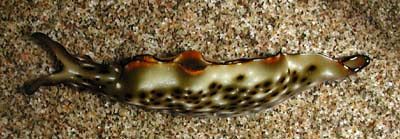
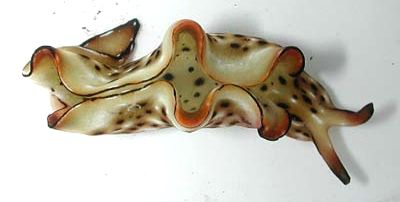
Dear Bill,
I found this during my recent trip to Christmas Island, Line Islands [Sep 2001].
I think this is probably a form of Elysia ornata. I found it crawling in the open, by day, while wading on a shallow reef platform just off the beach in front of the Captain Cook Hotel. It was at less than 0.5 m. It was about 25 mm in length.
Best wishes,
Cory
norm@maui.net
Pittman, C., 2001 (Oct 26) Elysia ornata from the Line Islands. [Message in] Sea Slug Forum. Australian Museum, Sydney. Available from http://www.seaslugforum.net/find/5553Thanks Cory,
Bill Rudman
Elysia ornata from Sulawesi
August 29, 2001
From: Mary Jane Adams
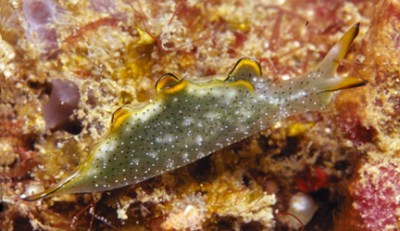
Hi Bill,
Here is another version of Elysia ornata.
Crawling length: 25 mm, Depth: about 15 meters, Divesite: Critter Hunt, Lembeh Straits, Sulawesi, Indonesia.
Best regards,
Mary Jane
divepng@yahoo.com
Adams, M.J., 2001 (Aug 29) Elysia ornata from Sulawesi. [Message in] Sea Slug Forum. Australian Museum, Sydney. Available from http://www.seaslugforum.net/find/5157Thanks Mary Jane,
Bill Rudman
Elysia ornata from Japan
August 19, 2001
From: Nishina Masayoshi
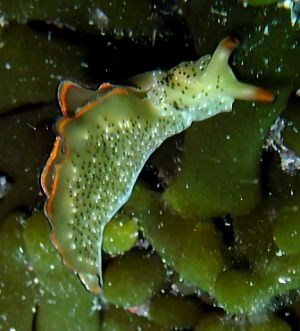
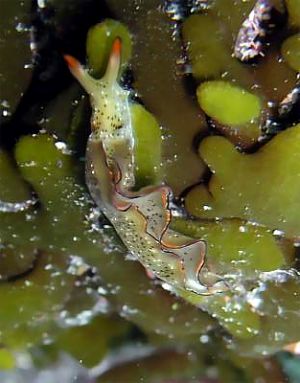
Dear Dr.Rudman,
Elysia ornata is common in Sagami Bay and at Hachijo.
Date: 29 June, 2001
Place: Sokodo Hachijo Island, Japan
Depth: 4m
Size: 30mm
Best Regards,
Nishina Masayoshi
nishina@hpe15.wips.co.jp
Nishina, M., 2001 (Aug 19) Elysia ornata from Japan. [Message in] Sea Slug Forum. Australian Museum, Sydney. Available from http://www.seaslugforum.net/find/4957Dear Nishina,
Thanks for these photos. The lower one is interesting because it shows the milky white defensive secretions E. ornata exudes when irritated - which can a nuisance if you are trying to photograph it. The white specks in its colour pattern are in fact glands. Many opisthobranchs have
defensive skin glands and we are still learning out how the secretions are produced. In some groups, such as the Chromodorididae the molecules are almost certainly modified from molecules obtained from their sponge food. In the case of the sacoglossans it is also likely that defensive plant poisons are being re-cycled by the sacoglossans. Have a look at my message on research that has been done on the secretions of Elysiella pusilla
Best wishes,
Bill Rudman.
Elysia ornata from Saudi Arabia
August 1, 2001
From: John Chuk

Dear Bill,
Looking through my collection I found this photo that you may like to add to the Elysia ornata page. I had identified this specimen as E. marginata but I understand the two species are now considered one and the same.
The photo was taken on 25 Sept 1992 near Ash Shuqaiq (about 400Km south of Jeddah), Saudi Arabia. The specimen is 18mm in length and was found feeding on algae at 0.5m depth on the reef flat. The species was found on several occassions at this site.
Best wishes,
John.
jchuk@giant.net.au
Chuk, J., 2001 (Aug 1) Elysia ornata from Saudi Arabia. [Message in] Sea Slug Forum. Australian Museum, Sydney. Available from http://www.seaslugforum.net/find/4892Thanks John,
Nice to see a bit more variation. I think we may have gone too far in lumping all the species with large parapodia together into one species but it is going to need some careful work worldwide to find out for sure. Photos like yours certainly help to give us a better idea of what is out there. By the time anatomists usually get to the specimens, their shape and colour has gone and their relying on collector's colour notes which may miss vital features. So keep on looking through your photo collection - your offerings are always welcome.
Best wishes,
Bill Rudman
Elysia ornata from American Samoa
July 21, 2001
From: Don Barclay
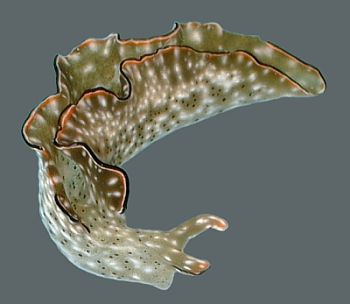
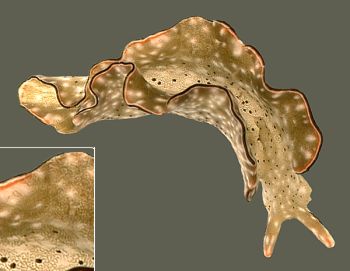
Hi Bill,
Here are a couple of pics of the "typical" Elysia ornata from American Samoa, as promised. The rhinophores are considerably different, at least in color, from the very dark ones. The dark Elysia will average a bit larger than the typical E. ornata, also.
This one was collected at 1800 local time on 13 July 2001, on an algae-covered coral head in about half a meter of water (low tide), middle of Coconut Point, Nu'uuli, American Samoa. 27mm long.
Larry Madrigal says there are several areas on the island where both the dark Elysia and normal E. ornata are found together, but they appear to be one form or the other without intergrades.
Cheers,
Don
n5ols@samoatelco.com
Barclay, D., 2001 (Jul 21) Elysia ornata from American Samoa. [Message in] Sea Slug Forum. Australian Museum, Sydney. Available from http://www.seaslugforum.net/find/4821Thanks Don,
This is certainly what I would call 'typical' Elysia ornata. I will be ineterested to hear Kathe Jensen's opinion on the dark ones.
Best wishes,
Bill Rudman
Elysia ornata from Papua New Guinea
July 21, 2001
From: Mary Jane Adams
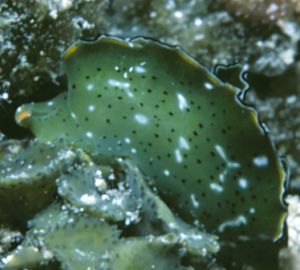
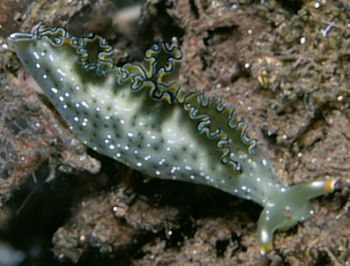
Hi Bill,
Here are a couple of Elysia ornata from Papua New Guinea. The UPPER image
I shot on a sand slope near Kavieng, New Ireland. The LOWER one is from Luadi in the Milne Bay area. Although difficult to see
on the scans, both animals have a row of small, widely spaced orange spots near the upper edge of the parapodia.
Best regards,
Mary Jane
divepng@yahoo.com
Adams, M.J., 2001 (Jul 21) Elysia ornata from Papua New Guinea. [Message in] Sea Slug Forum. Australian Museum, Sydney. Available from http://www.seaslugforum.net/find/4847Thanks Mary Jane,
This is one 'species' where I don't think we can get too many photos at present. To me 'typical' E. ornata has this thin very large parapodia with quite sinuous parapodial edge. I find it difficult to accomodate the animals in Erwin's Erwin's and Lindsay's messages to this 'body plan' - even with thin parapodia, so an assortment of photos like this may give some student the urge to investigate further.
Best wishes,
Bill Rudman
Re: Elysia sp. 11 from Sulawesi
June 28, 2001
From: Kathe R. Jensen
Dear Bill,
Now that you posted Lindsay's pictures with Elysia sp. 11, I guess I have to say something. Lindsay's latest pictures are definitely Elysia ornata - look at the thin edges of the parapodia, even where the orange band is broad, and even where the parapodial edges are flared. I wasn't quite sure about Erwin's picture, but I think that is also E. ornata. I tried to look for other differences, but could not see anything consistant. E. ornata often has small, thin, white papillae, Elysia sp. 11 appears smooth. Elysia sp. 11 does not have the black line on the parapodial edges, not even interrupted. The black spots of Elysia sp. 11 are usually bigger than those of E. ornata, and they often sit in the center of a larger white spot. I guess we cannot be certain about the identity of Elysia sp. 11 until "it has its teeth examined", to quote Sherman Bleakney.
Best wishes,
Kathe
jensen@ait.ac.th
Jensen, K.R., 2001 (Jun 28) Re: Elysia sp. 11 from Sulawesi. [Message in] Sea Slug Forum. Australian Museum, Sydney. Available from http://www.seaslugforum.net/find/4679Dear Kathe,
I am happy for you to 'say something' at any time, in fact I urge you to. In this case, without anatomical information it was a 50-50 choice on E. ornata and Elysia sp. 11. It is hard to determine the 'thin-ness' of the parapodia from the photos so I used the way the colour border is broken into three and the parapodial edge folded at these three places. I had never seen Elysia ornata with this character. Lindsay & Erwin, your animals are now on the Elysia ornata page. If anyone has photos of Elysia ornata showing thin parapodia and a broken colour band at the parapodial edge it would be useful addition to the discussion.
Best wishes,
Bill Rudman
Elysia sp. 11 from Sulawesi
June 26, 2001
From: Lindsay Warren
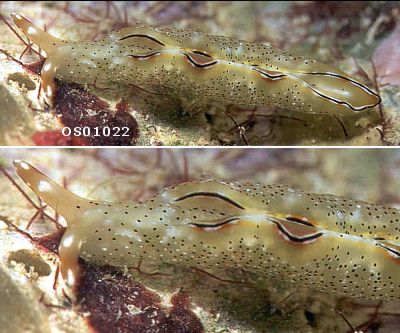
Dear Bill
On looking at Erwin Koehler's photo photo of an Elysia from the Philippines that you posted recently it reminded me of various specimens found in the Tukang Besi Archipelago, S.E. Sulawesi (Operation
Wallacea) to which we gave the temporary 'name' of OWN99. I have attached three photos of different specimens (OS0567 (Size: 16mm), OS0469 (Size: 4mm) & OS01022 (Size: 20 mm) all of which have thin parapodia with a thin intermittent black line along the edge followed by a thin intermittent white line and then a wider intermittent orange band. All resembled Elysia ornata except that the lines on the parapodia were incomplete and the overall colour considerably paler than other Elysia ornata specimens we have found. However, the most distinctive external differences were the very thick parapodia of Elysia sp. 11 which did not have a any black lines. Photos: Lindsay Warren.
When recently reading Carlson & Hoff (1978) I found that they mentioned that the parapodial lines on Elysia ornata could either be continuous or intermittent. So it may well be that OWN99 and Erwin Koehler's Elysia are in fact Elysia ornata although I know one cannot go by external features only.
• Carlson, C.H. & Hoff, P.J., (1978) The Identifiable Elysia from Guam (Elysiidae, Sacoglossa, Opisthobranchia). Micronesica, 14(1): 89-113.
All the best
Lindsay
alldcl@compuserve.com
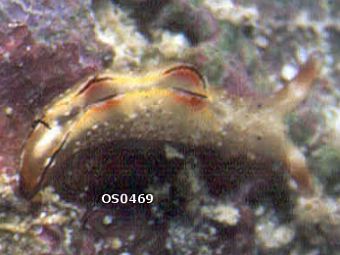
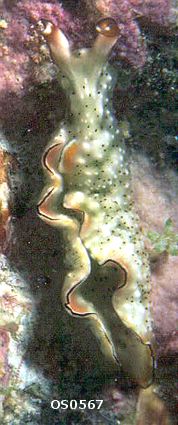
Thanks Lindsay,
There are certainly colour similarities but the parapodia of Elysia ornata are large and very thin. I would be very surprised if Elysia sp. 11 turned out to be Elysia ornata.
Best wishes,
Bill Rudman
Elysia sp. 11? from the Philippines
June 18, 2001
From: Erwin Köhler
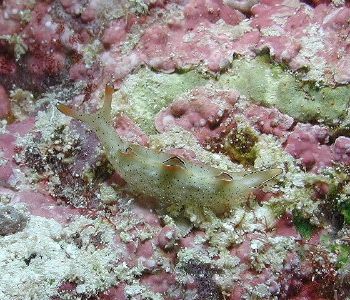
Dear Bill,
here is the next one from the Philippines, Cebu Island, Moalboal, divesite "Dolphin House", depth 8 m, length 23mm, May 27, 2001. Is it Elysia ornata, Elysia sp. 11 or something else?
Erwin
Erwin@medslugs.de
Köhler, E., 2001 (Jun 18) Elysia sp. 11? from the Philippines. [Message in] Sea Slug Forum. Australian Museum, Sydney. Available from http://www.seaslugforum.net/find/4595Dear Erwin,
It certainly looks like Elysia sp. 11, but as you suggest, has similarities to E. ornata. The way it is holding the parapodia to form three 'siphons', each edged with orange, would seem to be typical of Elysia sp. 11.
Best wishes,
Bill Rudman
Elysia from American Samoa
April 3, 2001
From: Don Barclay
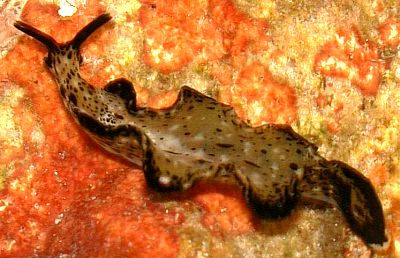
Hi Bill,
In an effort to clear up a few common but questionable species from American Samoa, I will probably be trickling some photos your direction over the next couple of months. I am leaving Samoa mid-year, so I won't have an extremely long time to tie up the loose ends.
Here is a fairly common Elysia species, collected intertidally on the afternoon of 30 March 2001, on the reef flat at Faga'alu, Tutuila Island, American Samoa. It measured around 35mm. Is this Elysia ornata? If so, then I will have to hit a different population of what I've been calling E. ornata and see what you think about the differences. The animals in that population have the submarginal orange band, and the rhinophores are mottled green with orange near the tips.
This one was fairly cooperative during the photography session, and I even got him to smile for the camera once...
Cheers,
Don
n5ols@samoatelco.com
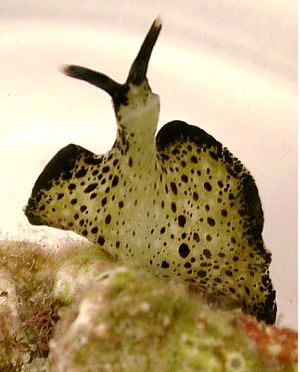
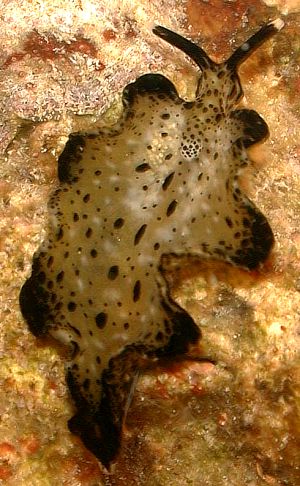
Dear Don,
Any information from Samoa is welcome. Even things which you consider to be common are of interest as there are very few records of sea slugs from Samoa.
It will be interesting to see what comments we get about this Elysia. I am not sure if it is Elysia ornata but I suppose it could be a very dark colour variety, without any orange. It would be good to see some photos of the other population you mention, with the more typical orange markings.
Best wishes,
Bill Rudman
Elysia ornata from French Polynesia
December 21, 2000
From: Daniel L. Geiger
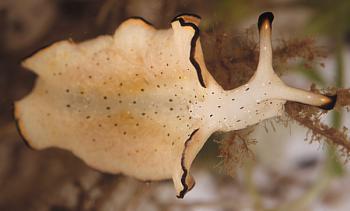
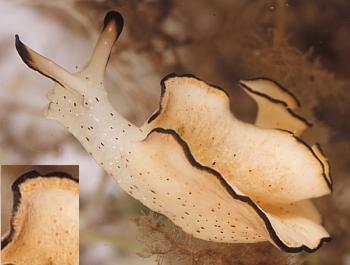
Here's an other species I recently collected in Moorea, French Polynesia, August 2000. I gather it is Elysia ornata.
[Details: 4525 Elysia sp. French Polynesia, Moorea VIII 2000. Provia 100F, 80mmM, 2x T-32, dorsal, lateral frontal. Cream body, black spots, black line along parapodia and anterior side of rhinophores, black tips of rhinophores. Specimen in LACM collection. Found by Oxford crew on seagrass]
Daniel
dgeiger@nhm.org
Geiger, D.L., 2000 (Dec 21) Elysia ornata from French Polynesia. [Message in] Sea Slug Forum. Australian Museum, Sydney. Available from http://www.seaslugforum.net/find/3309Thanks Daniel,
It's nice to get some photos of the various colour forms of this widely spread species. Your animal seems to be a bit short of chloroplasts, which in this species give it a bright green colour. They are normally distributed throughout the parapodia and in the body wall in fine branches of the gut.
Bill Rudman.
Elysia ornata from the Philippines
November 6, 1999
From: Erwin Koehler
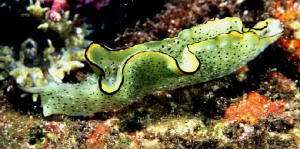
Bill,
Here is a photo of Elysia ornata (Swainson, 1840), from Lipayo, Negros Is., Philippines, November 1998
Erwin
Medslugs.Koehler@t-online.de
Koehler, E., 1999 (Nov 6) Elysia ornata from the Philippines. [Message in] Sea Slug Forum. Australian Museum, Sydney. Available from http://www.seaslugforum.net/find/1474Elysia ornata from Queensland
November 5, 1999
From: Tim Murrell
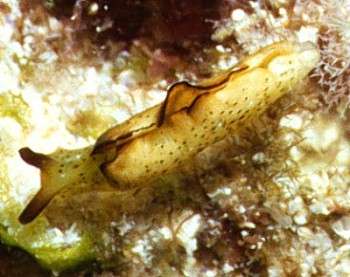
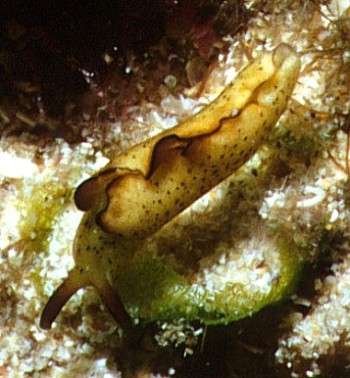
Dear Dr Rudman,
Could you please ID this nudibranch for me?
I am assuming that it is a species of Elysia, but I can't get any
further than that.
Both photos are of the same animal and were taken on 5 September 1999 in 10m of water on Flinders Reef, Moreton Island, SE Queensland, Australia.
The animal itself was approx 50mm.
Thank you in advance.
Tim Murrell.
timm@powerup.com.au
Murrell, T., 1999 (Nov 5) Elysia ornata from Queensland. [Message in] Sea Slug Forum. Australian Museum, Sydney. Available from http://www.seaslugforum.net/find/1489Dear Tim,
Yes it's an Elysia, E. ornata. It used to be known as Elysia marginata but it is now considered that this Indo-West Pacific species and a very similarly coloured Caribbean species are the same. The species seems somewhat variable in background colour but is characterised by the black marginal and orange-yellow submarginal bands. It's reported to feed on Bryopsis, but I am not sure if that means it doesn't feed on other algae as well.
Bill Rudman.
